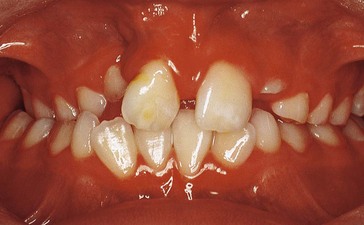21 Cleft lip and palate
Summary
Karen, a 9-year-old girl, is unhappy about the appearance of her teeth (Fig. 21.1). What is the cause and how will it be treated?
History
Family history
There is no family history of cleft lip and palate.
 How does this malformation occur?
How does this malformation occur?
Karen has been attending a cleft clinic at the regional dental teaching hospital since birth.
Primary dentition
Regular speech and hearing assessments should be undertaken; consider closure of any palatal fistulae to assist speech development. Consider pharyngoplasty to reduce velopharyngeal incompetence at 4–5 years, thereby attempting to improve any nasal intonation to speech.
As a general dental practitioner your role is to:
Provide dietary advice and oral hygiene instruction to the parents, at regular intervals, from eruption of the primary incisors.
Consider the use of fluoride tablets if the level of fluoride in the local domestic water supply is below 1 ppm.
Your particular aim in dental care is to promote and maintain excellent dental health for Karen, thereby avoiding the need for restorative treatment or enforced loss of primary teeth through dental caries.
 What skeletal/dental/occlusal problems are commonly found with cleft lip and palate?
What skeletal/dental/occlusal problems are commonly found with cleft lip and palate?
Skeletally, there is a tendency for the maxilla and mandible to be retrognathic, the upper facial height to be reduced and the lower facial height to be increased. A Class III skeletal pattern is common.
Stay updated, free dental videos. Join our Telegram channel

VIDEdental - Online dental courses






